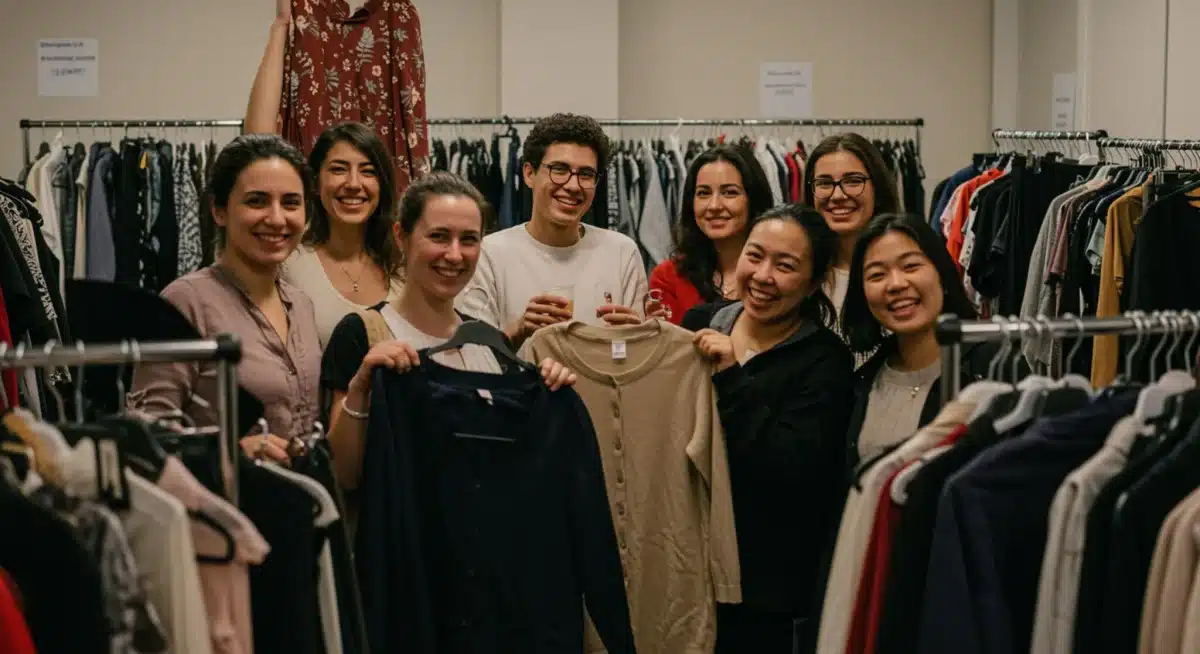Spring 2025: Sustainable Fashion Essentials for Your Wardrobe

Spring 2025 is set to redefine fashion with a strong emphasis on sustainability, presenting an exciting opportunity to embrace revolutionary eco-friendly pieces that blend style with environmental responsibility in your wardrobe.
As the fashion world continually evolves, Spring 2025 marks a pivotal moment where style and sustainability converge. It’s time to consider how to incorporate sustainable fashion spring 2025 into your wardrobe, making conscious choices that benefit both your personal aesthetic and the planet. This season promises innovative materials, ethical production, and timeless designs that will transform how you think about dressing.
Understanding the Shift Towards Sustainable Fashion
The fashion industry has long been a significant contributor to environmental degradation, from excessive water consumption to chemical pollution and textile waste. However, a powerful paradigm shift is underway, driven by both consumer demand and industry innovation. Understanding this movement is the first step toward building a truly sustainable wardrobe for Spring 2025 and beyond.
This shift isn’t just a trend; it’s a fundamental reevaluation of how clothes are made, consumed, and disposed of. Brands are increasingly adopting practices that prioritize the planet and its people, moving away from fast fashion’s detrimental cycle. Consumers, in turn, are becoming more informed and demanding transparency, leading to a more accountable and responsible industry.
The Environmental Impact of Fast Fashion
Fast fashion’s model of rapid production, low prices, and disposable clothing has severe consequences. It depletes natural resources, generates immense waste, and often involves exploitative labor practices. Recognizing these impacts is crucial for anyone looking to make more responsible choices.
- Water Consumption: Producing cotton, for example, is incredibly water-intensive, often in regions already experiencing water scarcity.
- Chemical Pollution: Dyes and finishes used in textile production contaminate waterways and harm ecosystems.
- Waste Generation: Millions of tons of textiles end up in landfills annually, where synthetic fibers can take centuries to decompose.
- Carbon Emissions: The global supply chain of fast fashion contributes significantly to greenhouse gas emissions.
The Rise of Ethical Production
Ethical production goes beyond environmental concerns to encompass fair labor practices, safe working conditions, and fair wages for garment workers. Many sustainable brands are committed to ensuring every person involved in their supply chain is treated with dignity and respect. This holistic approach is what truly defines sustainable fashion.
Choosing brands that are transparent about their production processes and labor standards empowers consumers to support a more just and equitable industry. Certifications from organizations like Fair Trade or GOTS (Global Organic Textile Standard) can help identify brands that adhere to these high ethical benchmarks.
The movement toward sustainable fashion is a comprehensive one, addressing environmental, social, and economic aspects. It encourages a mindful approach to consumption, valuing quality over quantity and longevity over fleeting trends. Embracing this shift means contributing to a healthier planet and a more ethical global community.
Innovative Materials Shaping Spring 2025 Collections
The backbone of sustainable fashion spring 2025 lies in the groundbreaking materials being developed and adopted by designers. These innovations are not only eco-friendly but also offer superior comfort, durability, and style, proving that sustainability doesn’t mean compromising on aesthetics or quality. From regenerated fibers to plant-based alternatives, the options are expanding rapidly.
Designers are actively seeking out textiles that minimize environmental impact at every stage of their lifecycle, from cultivation or production to disposal. This focus on material science is driving a new era of fashion that is both beautiful and responsible, allowing consumers to make choices that align with their values without sacrificing modern trends.
Recycled and Upcycled Fabrics
Recycling and upcycling waste materials into new textiles are central to reducing landfill burden and conserving resources. Recycled polyester, made from plastic bottles, and regenerated nylon, often sourced from fishing nets, are becoming commonplace in activewear and outerwear, demonstrating versatility and performance.
- Recycled Polyester (rPET): Offers similar properties to virgin polyester but uses significantly less energy and diverts plastic waste.
- Regenerated Nylon (ECONYL): Transforms nylon waste into a high-quality yarn that can be recycled infinitely without losing quality.
- Upcycled Materials: Involves repurposing existing garments or textile scraps into new designs, reducing the need for new raw materials.
Plant-Based Alternatives to Traditional Fabrics
Beyond conventional organic cotton, a new wave of plant-based materials is emerging as sustainable alternatives. These innovative textiles often require less water, land, and pesticides than their traditional counterparts, offering exciting possibilities for future collections.
Materials like Tencel (lyocell), derived from sustainably sourced wood pulp, and Piñatex, a leather alternative made from pineapple leaf fibers, are gaining traction. These materials not only have a lower environmental footprint but also boast unique textures and properties that appeal to designers and consumers alike.

The continuous development of these innovative materials is a testament to the fashion industry’s commitment to sustainability. As these textiles become more widely available and refined, they will increasingly define the aesthetic and performance of sustainable fashion, making eco-conscious choices more accessible and appealing to a broader audience.
Key Sustainable Fashion Pieces for Your Spring 2025 Wardrobe
Building a sustainable wardrobe for Spring 2025 is about making intentional choices that align with your values and personal style. This season emphasizes versatility, timelessness, and pieces crafted from eco-friendly materials. Focusing on quality over quantity will ensure your investments last beyond a single season, reducing your overall consumption.
Think about foundational items that can be mixed and matched, creating numerous outfits with fewer pieces. Integrating these sustainable essentials will allow you to stay stylish and conscientious, embodying the spirit of responsible fashion.
The Organic Cotton Essentials
Organic cotton remains a cornerstone of sustainable fashion due to its reduced environmental impact compared to conventional cotton. For Spring 2025, look for elevated basics that form the backbone of any versatile wardrobe.
- Relaxed-Fit Organic Cotton T-Shirts: Perfect for layering or wearing on their own, offering comfort and breathability.
- Organic Cotton Wide-Leg Trousers: A chic and comfortable alternative to denim, ideal for warmer weather.
- Classic Organic Cotton Poplin Shirt: A versatile piece that can be dressed up or down, offering timeless appeal.
Linen Blends and Hemp Fabrics
Linen and hemp are celebrated for their durability, breathability, and minimal environmental footprint. These natural fibers are excellent choices for spring, providing comfort and a sophisticated, relaxed aesthetic.
Consider lightweight linen dresses, tailored hemp blazers, or flowing linen-blend skirts. These materials are naturally cooling, making them perfect for the rising temperatures of spring, and they age beautifully, becoming softer with each wash.
Innovative Accessories: Recycled and Upcycled
Accessories play a crucial role in completing an outfit, and Spring 2025 brings a wealth of sustainable options. Look for bags made from recycled materials, jewelry crafted from upcycled metals, or shoes with soles made from natural rubber or recycled plastic.
These accessories not only add a unique touch to your look but also highlight your commitment to conscious consumption. Investing in high-quality, sustainably made accessories means they will stand the test of time, reducing the need for frequent replacements.
By carefully selecting these key sustainable pieces, you can curate a Spring 2025 wardrobe that is both fashionable and environmentally responsible. Each item chosen contributes to a larger movement towards a more ethical and sustainable future for fashion.
Embracing Circularity: Beyond Buying New
The concept of circularity is vital in sustainable fashion, extending beyond merely purchasing eco-friendly items. It encompasses the entire lifecycle of a garment, from design to end-of-life, encouraging practices that keep materials in use and minimize waste. Embracing circularity means rethinking our relationship with clothes and actively participating in systems that promote reuse and regeneration.
This approach challenges the traditional linear model of ‘take, make, dispose’ by advocating for products designed for longevity, repair, and eventual recycling. For Spring 2025, consider how you can integrate circular principles into your wardrobe choices and habits.
The Power of Secondhand and Vintage
One of the most impactful ways to practice sustainable fashion is by embracing secondhand and vintage clothing. Shopping pre-loved items significantly reduces demand for new production, conserving resources and preventing garments from ending up in landfills prematurely.
- Thrift Stores and Consignment Shops: Discover unique pieces and extend the life of existing garments.
- Online Resale Platforms: Access a wider selection of brands and styles from the comfort of your home.
- Vintage Boutiques: Find high-quality, often one-of-a-kind items with historical charm.
By giving clothes a second life, you’re not only making an eco-conscious choice but also cultivating a distinctive personal style that stands out from mass-produced trends. The thrill of finding a hidden gem is an added bonus.
Repair, Repurpose, and Rent
Extending the lifespan of your existing wardrobe through repair and repurposing is another cornerstone of circular fashion. Instead of discarding items with minor flaws, consider mending them or transforming them into something new.
Additionally, clothing rental services are gaining popularity, offering a sustainable alternative for special occasions or trying out new styles without the commitment of purchase. This reduces individual consumption and promotes shared resource use, aligning perfectly with circular economy principles.

Embracing circularity means adopting a holistic mindset towards your wardrobe. It’s about valuing resources, reducing waste, and participating in an economic model that benefits both people and the planet. For Spring 2025, make conscious efforts to keep your clothes in circulation for as long as possible.
Supporting Ethical Brands and Transparency
Navigating the sustainable fashion landscape can be complex, but supporting ethical brands with transparent practices is a clear path forward. These brands are committed not only to environmental responsibility but also to fair labor practices throughout their supply chains. Knowing who made your clothes and under what conditions is a powerful step towards a more ethical wardrobe for Spring 2025.
True sustainability extends beyond materials; it encompasses the entire ecosystem of production. Ethical brands often go above and beyond industry standards, ensuring fair wages, safe working environments, and community engagement. Their commitment to transparency allows consumers to make informed decisions and hold companies accountable.
Identifying Genuinely Sustainable Brands
With the rise of ‘greenwashing,’ it can be challenging to distinguish genuinely sustainable brands from those merely claiming to be. Look for specific certifications, detailed impact reports, and clear communication about their supply chain.
- Certifications: Labels like GOTS (Global Organic Textile Standard), Fair Trade, B Corp, and OEKO-TEX provide independent verification of sustainable and ethical practices.
- Transparency Reports: Brands that share detailed information about their factories, material sourcing, and environmental footprint are demonstrating true commitment.
- Mission-Driven Values: Research the brand’s core values and see if they align with your own commitment to sustainability and ethics.
The Importance of Supply Chain Visibility
A transparent supply chain means that a brand can trace its products from raw material to finished garment. This visibility is crucial for ensuring ethical labor practices and minimizing environmental harm at every stage of production.
Brands that invest in supply chain transparency often engage directly with their suppliers, fostering long-term relationships and ensuring fair treatment of workers. This level of oversight helps prevent issues like child labor, unsafe conditions, and exploitative wages, which are unfortunately still prevalent in parts of the fashion industry.
By actively seeking out and supporting brands that prioritize ethical production and transparency, consumers can wield significant power. Every purchase becomes a vote for a more responsible and equitable fashion industry, driving positive change and making a real difference in the world of sustainable fashion spring 2025.
Making Sustainable Choices a Lifestyle
Integrating sustainable fashion into your Spring 2025 wardrobe is more than just buying new eco-friendly clothes; it’s about adopting a mindful lifestyle that extends to all aspects of consumption. It involves a shift in perspective, moving away from impulsive purchases and embracing a more thoughtful, intentional approach to dressing. This lifestyle change is empowering, allowing you to align your daily choices with your values.
Sustainable living is a continuous journey of learning and improvement. By making small, consistent changes, you can gradually build a wardrobe that not only looks good but also feels good, knowing its positive impact on the world. This approach encourages creativity, resourcefulness, and a deeper appreciation for the items you own.
Mindful Consumption Habits
At the heart of a sustainable lifestyle is mindful consumption. Before making a purchase, ask yourself if you truly need the item, how long it will last, and if it aligns with your existing wardrobe. This critical evaluation helps reduce unnecessary purchases and promotes a more curated collection of garments.
- Consider the ‘Cost Per Wear’: Invest in high-quality, durable pieces that will last for years, rather than cheap, disposable items.
- Plan Your Purchases: Create a list of what you genuinely need to avoid impulse buying.
- Research Before Buying: Look into brands’ sustainability claims and ethical practices.
Caring for Your Clothes to Extend Their Life
Proper garment care is an often-overlooked aspect of sustainable fashion. By following care instructions, washing clothes less frequently, and air-drying when possible, you can significantly extend the life of your garments and reduce their environmental impact. This simple practice saves water, energy, and reduces microplastic shedding from synthetic fibers.
Learning basic repair skills, such as sewing on a button or mending a small tear, also contributes to longevity. These small acts of care transform clothes from disposable items into cherished possessions, fostering a more sustainable relationship with your wardrobe.
Ultimately, making sustainable choices a lifestyle means cultivating a deeper connection to your clothes and the resources used to create them. It’s about conscious decisions, from purchase to care, that collectively contribute to a more sustainable future for fashion and the planet. Embrace this journey for Spring 2025 and beyond.
The Future of Sustainable Fashion Beyond Spring 2025
While Spring 2025 sets a promising stage for sustainable fashion, the trajectory for the industry points towards even greater innovation and integration of eco-conscious practices. The future is bright, with ongoing research into new materials, advanced recycling technologies, and a growing consumer demand for transparency and ethical production. This evolution signifies a permanent shift, not just a passing trend.
Expect to see more brands adopting a holistic view of sustainability, encompassing everything from regenerative agriculture for natural fibers to closed-loop manufacturing systems. The goal is to create a fashion ecosystem where waste is minimized, resources are continually reused, and all participants in the supply chain are treated fairly.
Technological Advancements in Textile Production
Breakthroughs in biotechnology and material science are paving the way for revolutionary textiles. Scientists are exploring lab-grown materials, such as synthetic spider silk or mushroom-based leathers, which offer high performance with minimal environmental impact. These innovations have the potential to drastically reduce reliance on traditional resource-intensive materials.
- Bio-fabricated Materials: Textiles grown from microorganisms, offering alternatives to animal products and synthetic fibers.
- Advanced Recycling: Chemical recycling processes that can break down complex textile blends into their original monomers, allowing for indefinite recycling.
- 3D Printing and On-Demand Manufacturing: Reducing waste by producing garments only when needed, minimizing overproduction.
Policy and Industry Collaboration
Government policies and industry-wide collaborations will play a crucial role in accelerating the transition to a fully sustainable fashion system. Regulations on waste, chemical use, and labor standards, combined with initiatives that promote circularity and innovation, will drive systemic change.
Collaborative efforts among brands, suppliers, innovators, and consumers are essential to developing shared standards and infrastructure for a truly sustainable future. These partnerships will help scale up sustainable solutions and make them accessible to a wider market.
The journey towards a fully sustainable fashion industry is ongoing, with Spring 2025 serving as an important milestone. The convergence of consumer awareness, technological innovation, and industry commitment promises a future where fashion is not only beautiful but also inherently responsible and regenerative.
| Key Aspect | Brief Description |
|---|---|
| Innovative Materials | Focus on recycled fibers, plant-based alternatives, and bio-fabricated textiles to reduce environmental impact. |
| Circularity | Embracing secondhand, vintage, repair, repurpose, and rental models to extend garment life and minimize waste. |
| Ethical Production | Supporting brands with transparent supply chains, fair labor practices, and verifiable certifications. |
| Mindful Consumption | Adopting conscious buying habits and proper garment care to reduce environmental footprint and promote longevity. |
Frequently Asked Questions About Sustainable Fashion
Sustainable fashion for Spring 2025 is defined by its commitment to eco-friendly materials like organic cotton, recycled polyester, and plant-based alternatives, coupled with ethical production practices. It emphasizes durability, timeless design, and a minimized environmental footprint throughout a garment’s lifecycle, promoting conscious consumerism and circularity.
To identify genuinely sustainable brands, look for third-party certifications such as GOTS, Fair Trade, or B Corp. Transparency in their supply chain, detailed impact reports, and clear communication about their sourcing and manufacturing processes are also strong indicators of authentic commitment to sustainability and ethical practices.
Key sustainable materials for Spring 2025 include organic cotton, known for its reduced water and pesticide use, and recycled polyester (rPET) made from plastic waste. Other innovative materials gaining traction are Tencel (lyocell) from wood pulp, hemp, linen, and regenerated nylon (ECONYL) from ocean waste.
Beyond new purchases, you can make your wardrobe more sustainable by embracing circularity. This includes shopping secondhand, vintage, and consignment. Additionally, focus on repairing and repurposing existing garments, utilizing clothing rental services, and practicing mindful consumption by extending the life of your clothes through proper care.
Absolutely not. Sustainable fashion, especially in Spring 2025, is proving that eco-consciousness does not mean compromising on style or quality. Innovative materials offer superior comfort and durability, while designers are creating timeless, chic pieces that rival traditional fashion, often with enhanced craftsmanship and unique aesthetic appeal.
Conclusion
The movement towards sustainable fashion spring 2025 is more than a fleeting trend; it represents a fundamental and necessary evolution in how we approach clothing. By embracing innovative materials, supporting ethical brands, and adopting circular practices, consumers have the power to revolutionize their wardrobes and contribute to a healthier planet. This season offers an exciting array of choices that prove style and sustainability can coexist beautifully, paving the way for a more responsible and conscious future in fashion. Making thoughtful decisions about what we wear is a powerful act of environmental stewardship and personal expression.





